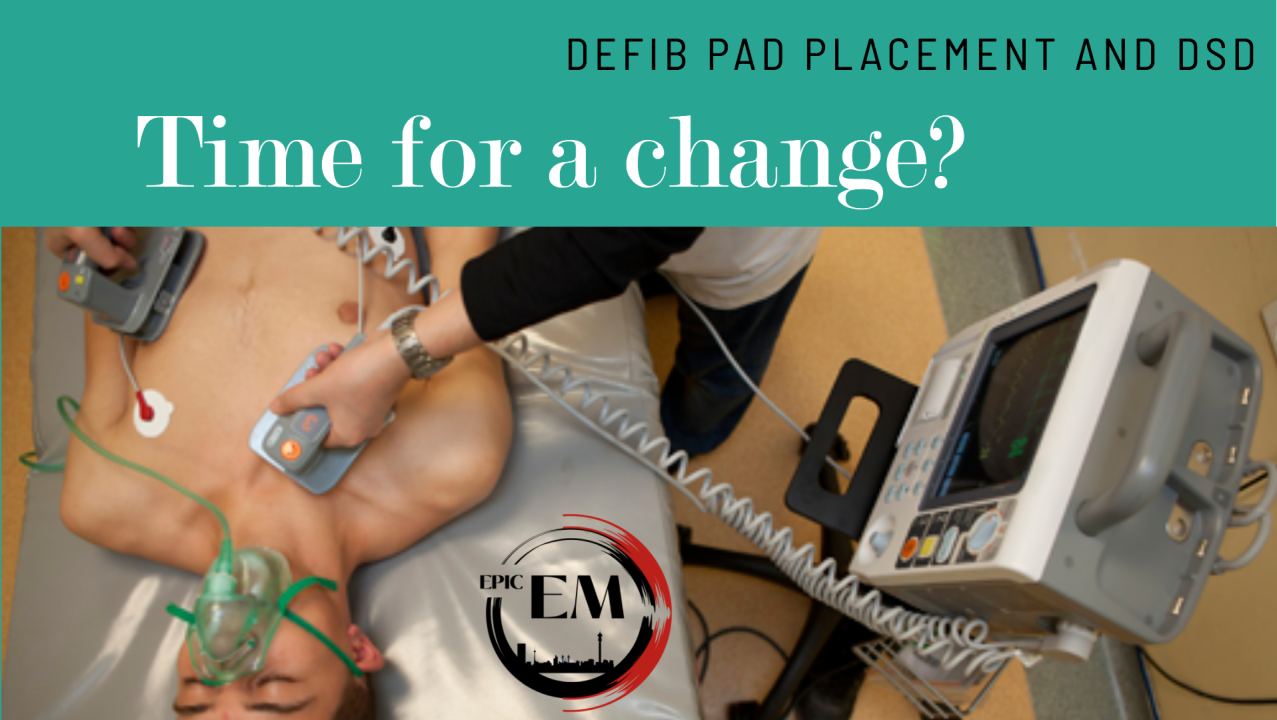In a recent discussion on his blog and site – Scott Weingart interviews Sheldon Cheskes, lead author of the Dose VF study (see the post on our Patreon page for the articles refernced in this post).
Some definitions first:
- Refractory VF: Persistent VF despite three consecutive shocks.
- Recurrent VF: Episodes where VF resolves temporarily (e.g., post-shock ROSC or PEA/asystole) but reverts shortly after.
- Electrical storm: Rapidly recurring VF without sustained ROSC.
Major take homes
Among other things, the bottom line from this discussion included the following:
- Time in VF is the most important outcome changer – the longer the patient is in VF for, the longer they seem to stay in VF for, and the less likely they are to stay out of VF even once shocked out. An earlier move to more advanced shocking strategies (before the 4th shock) might be more useful (DSED) to limit time in VF.
- Pad placement is more important than shock dose in successfully delivering current to the heart. Anterior/Posterior Pad placement seems to be the most effective position to achieve the best outcomes (there is increasing evidence in favour of this finding).
Just these two suggestions will create some changes in practice, and application in the clincial environment will need to be carefully thought out and practiced in order to acheive better patient outcomes.
Some comments and ideas to consider:
Why Anterior-Posterior (AP) might be Superior
1. Enhanced Current Delivery: The AP position provides a more direct electrical vector through the myocardium, optimizing current flow and reducing impedance. This results in a higher current delivered to the myocardium – which has the MOST effect on the conversion of VF to another possible perfusing rhythm.
2. More cardiac cells hit simultaneously: AP positioning facilitates more uniform myocardial depolarization, reducing the likelihood of residual VF in small areas or areas not affected by the defibrillation when pads are placed Anterior-Lateral. We tend to think of a defib dose hitting the whole heart at once, but it seems like it is possible to have some of the muscle stop fibrillating, and some of the muscle that is not affected will carry on fibrillating – leading to poor perfusion, oxygen delivery and a high risk of recurrent fibrillation.
3. Better Compatibility with Dual-Sequential Defibrillation (DSD): AP placement complements DSD strategies by maximizing shock efficacy through the heart’s electrical axis.
4. Impedance Dynamics: AP placement seems to decrease impedance fluctuations, ensuring consistent current delivery, impedance also seems to decrease with subsequent shocks.
5. Intermittent ROSC: Combining AP positioning with DSD significantly shortens VF duration, increasing the likelihood of sustained ROSC, and increasing the chance of survival with meaningful neurological outcomes.
How do we get this pad placement right?
- Try to anticipate the cardiac arrest where possible – all patients who present with high-risk cardiac states (ST elevation or depression and ongoing ischemia, ectopic beats, ongoing chest pain or previous dysrhythmias) should have pads placed BEFORE the arrest. If this can be anticipated, there is very little challenge in placing pads on an awake and cooperative patient, or a patient who can be easily rolled to the side (one who is not having CPR done).
- In the arrest, emphasis should be placed on a swift roll to the side, removal of clothing, and placement of the pads even if this pause takes longer than 10 seconds, as it seems that the defibrillation in the AP position is much better than AL – and is worth the time it might take to place the posterior pad.
- Resus teams should practice this in simulation, using real human weight to get it right, as well as practicing the ideal placement of the posterior pad often from both the left and right to ensure that it is not done for the first time in a patient who is already in arrest.
When to think about DSD?
It seems that within the first 4 shocks (8 minutes of cardiac arrest management with a defibrillator) it is reasonable to consider applying DSD to the patient, if the above information is applied – the first set of pads will already be in AP placement- and the additional set of pads will simply need to be added.
Getting DSD Right
Dual Sequential Defib is just that – sequential in nature – two defibs (or an AED and a defib) are applied to the patient with the two different pad placements. The monitors are charged up at the same time – to the manufacturers recommended dose for the patient, and one or two providers are expected to deliver the shock sequentially – within 600ms of each other.
It is recommended that the first person deliver their shock on a countdown from 3 – 2 – 1 – Shock (deliver the shock on the count of 1) and the second person to deliver on the count of “shock”. This will allow a short pause between the two doses.
It seems to be supported by the literature that the shorter the time between these two doses the better, but they should not be delivered at exactly the same time as there is a potential risk of the defib devices defibrillating each other… though this seems to be something that has never been reported.
Time off the chest is still vital – and there should be a limit of no more than 10 seconds for this peri-shock pause before CPR is initiated again. Chest compression fraction still remains the most important part of the approach.
High-quality CPR still matters, CCF still matters. Early defib – with two defibs (DSD) and pads in the right place now also matter!
What does this mean for the average provider?
The guidelines have not yet been changed to reflect these updates, and likely wont still for another cycle, although the RCT this information is based on appears to be reasonable, guidelines NEVER change for a single study.
What this means for the average provider is that guidelines are there for the safety of the vast majority of patients, but don’t meet the requirements for all patients, especially when the patient presents with something we have not got a lot of data about. Use your clinical knowledge, read the studies that are available, and consider approaching the system you work in to decide if the data should be adopted. The guidelines don’t treat patients – you do…
This article is not medical advice, local protocols and medical direction should always be followed. But where reasonable also challenged.
References:
Cheskes, S., Verbeek, P.R., Drennan, I.R., McLeod, S.L., Turner, L., Pinto, R., Feldman, M., Davis, M., Vaillancourt, C., Morrison, L.J., Dorian, P. and Scales, D.C., 2022. Defibrillation strategies for refractory ventricular fibrillation. The New England Journal of Medicine, 387(21), pp.1947-1956. DOI: 10.1056/NEJMoa2207304.
Scott Weingart, MD FCCM. EMCrit 392 – All Things Defibrillation with Sheldon Cheskes. EMCrit Blog. Published on January 10, 2025. Accessed on January 13th 2025. Available at [https://emcrit.org/emcrit/all-things-defibrillation/ ].
External Links and further reading
- Article: Defibrillation Strategies for Refractory Ventricular Fibrillation
- Editorial: Defibrillation after cardiac arrest- is it time to change practice?
- Further reading: first10EM: Dose VF: A double sequential defibrillation game changer?
- Further reading: REBELEM: The DOSE VF Pilot RCT: Double Sequential External Defibrillation for Refractory Ventricular Fibrillation
- Further reading: St Emlyns JC- Alternative defibrillation strategies in refractory VF. The Dose VF trial.





